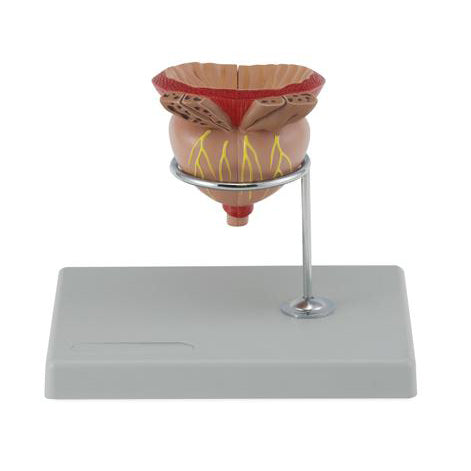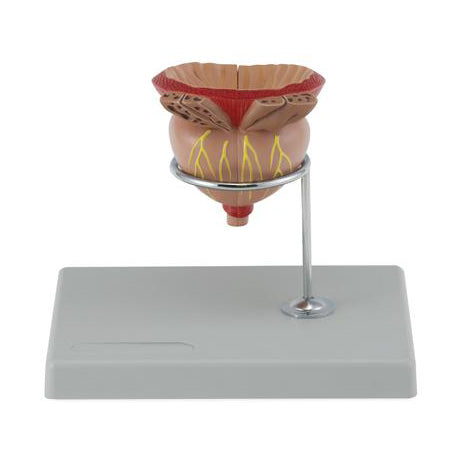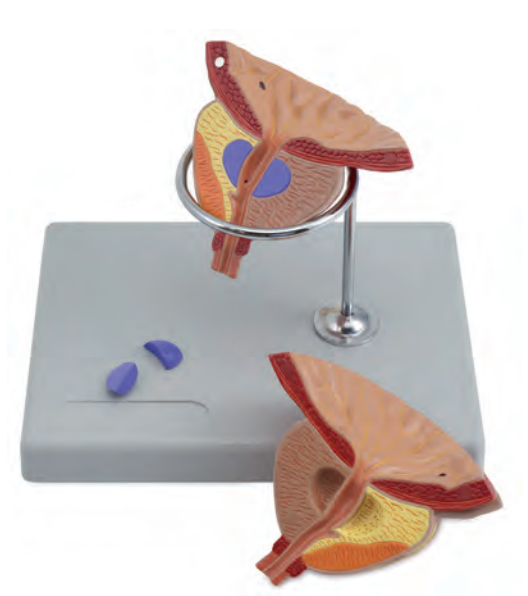SKU:EA1-6180.32
Educational and enlarged model of the prostate (bladder neck gland), part of the urethra and part of the urinary bladder
Educational and enlarged model of the prostate (bladder neck gland), part of the urethra and part of the urinary bladder
Out of stock
this product is made to order. To place an order please call or write us.Couldn't load pickup availability
If you are looking for an educational and enlarged model of the prostate (bladder neck gland) and its relationship to the urethra and urinary bladder, this model is ideal.
Compared to the man's prostate, the model is approximately 2 times enlarged. The height is 9 cm and the diameter is 10 cm. The prostate model can be separated into 4 parts (see images on the left) and special anatomical areas are shown in educational colors. Read more about this in the discussion of anatomy below. It is delivered on a stylish and removable stand.
Anatomical features
Anatomical features
Anatomically speaking, the model shows the following (mentioned from the top of the model down):
The lower part of the urinary bladder (the ureters are not visible)
The 2 ampulla ductus deferentis (the last piece of the vas deferens)
The 2 vesicula seminalis (the seminal vesicles)
Prostate (bladder neck gland) with small nerves on the outside
The urethra (the part that runs through the prostate and a short section below)
M. sphincter urethrae (around the model's last short piece of urethra below the prostate)
Educational colors
Most prostate models on the market show the entire organ in one color. On this model, there are educational colors, which is why you can focus on the different areas of the gland. Therefore, the model is obvious to focus on the "pathoanatomical" differences between BPH (benign prostatic hyperplasia) and prostate cancer (as well as urethral stricture, which is a narrowing of the urethra).
In the prostate, a secretion is formed via many small glands in the tissue. Anatomically, these small glands are located in 3 concentric zones, which are partially shown on the model:
1) The peripheral zone at the very end of the prostate (seen on the model in brown, yellow and orange)
2) The central zone (seen on the model in blue color)
3) The periurethral zone close around the urethra (however, cannot be distinguished from the central zone on the model because they both appear in the same blue color)
Many men are affected by BPH, which is localized to the glands in the periurethral zone. On the model, this corresponds to the part of the blue area closest to the urethra. BPH causes growth of the prostate, which can result in various urinary problems and the risk of pinching off the urethra.
Prostate cancer (prostate cancer), on the other hand, occurs primarily in glands in the peripheral zone. On the model, this thus corresponds to the brown, yellow and orange areas. The fact that the cancer primarily occurs in this "outer part" of the prostate means that urination genes only appear late in cancer development.
Urethral stricture results from a narrowing of the urethra due to scarring of the urethral mucosa. The mucosa is the part of the urethra that is in contact with its lumen, in which the urine resides. The mucous membrane is clearly visible on the model.
Product flexibility
Product flexibility
Clinical features
Clinical features
Clinically, the model is ideal for understanding BPH (benign prostatic hyperplasia), prostate cancer and urethral stricture. The model can also be used to understand other diseases/disorders such as prostatitis and diseases of the bladder such as bladder cancer.
Share a link to this product

A safe deal
For 19 years I have been at the head of eAnatomi and sold anatomical models and posters to 'almost' everyone who has anything to do with anatomy in Denmark and abroad. When you shop at eAnatomi, you shop with me and I personally guarantee a safe deal.
Christian Birksø
Owner and founder of eAnatomi ApS




